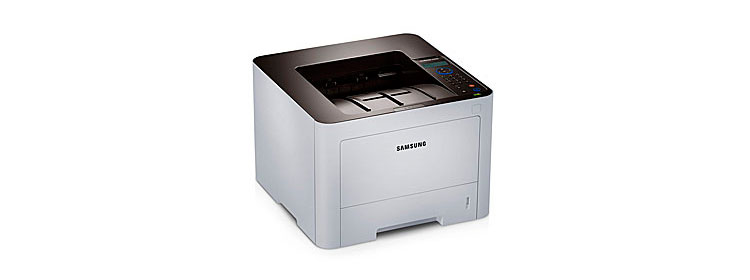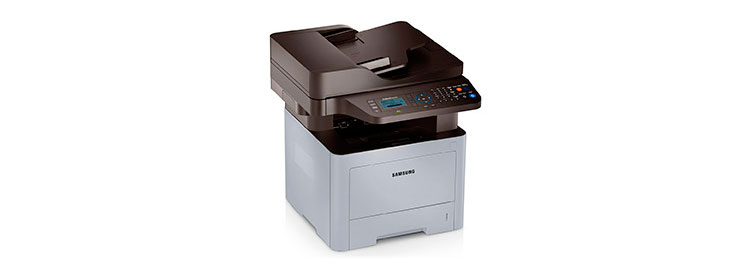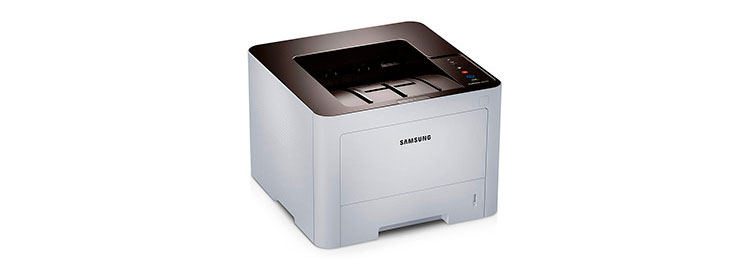Basically a heavier-duty version of the Samsung Printer ProXpress M3320ND$139.99 at Amazon that I recently reviewed, the Samsung Printer ProXpress M4020ND$263.97 at Amazon offers similar output quality and features, but with somewhat better paper handling and a higher monthly duty cycle. The combination makes it a particularly good fit for a micro or small office with heavy-duty print needs.
When I reviewed the M3320ND, I pointed out that although its one-sheet manual feed is useful, it’s a wimpy alternative to a multipurpose tray. The M4020ND solves that problem by including a 50-sheet multipurpose tray standard, along with its 250-sheet paper drawer and built-in duplexer (for printing on both sides of the page). That should be enough for most small offices, but if you need more, you can also add a 520-sheet second drawer ($200 street) for a total 820-sheet capacity.
The second key difference between the two is that the M4020ND’s maximum monthly duty cycle, at 100,000 pages per month, is twice the 50,000 pages the M3320ND is rated for. Keep in mind that maximum duty cycles are far higher than recommend maximums. Also, as with any printer, if you hit the maximum every month it probably won’t last all that many months. The point here is that the M4020ND is designed to print a lot more pages per month than the M3320ND without breaking.
Beyond these differences, the two printers offer almost identical features, including printing though the cloud, with built-in support for Google Cloud Print, and printing from mobile devices connecting to a Wi-Fi access point on your network, using either AirPrint or Samsung’s own mobile print app.
Setup and Speed
Setting up the M4020ND is identical to setting up the M3320ND, which makes setup absolutely standard for a mono laser. Here too, Ethernet and USB are the only connection choices. For my tests, I used Ethernet to connect to a network and printed from a system running Windows Vista.
Samsung rates the M4020ND at 42 pages per minute (ppm), which should be close to the speed you’ll see when printing text or other output that needs little to no processing. With pages that include graphics, photos, or other information that needs processing, however, the speed is much slower and not much different than you’ll see with the M3320ND’s 35-ppm engine.
On our business applications suite (timed with QualityLogic’s hardware and software), I clocked the M4020ND at a respectable, but not impressive, 11.5 ppm, which counts as a tie with the M3320ND, at 11.3 ppm. It’s also just a touch faster than the Editors’ ChoiceBrother HL-6180DW$288.99 at TheNerds.net, at 10.7 ppm, but significantly slower than the Editors’ Choice Dell B2360dn$259.99 at Dell, at 15.0 ppm.
Output Quality
Output quality for M4020ND is in much the same category as the speed: acceptable for most business needs, but not impressive. Text quality is within the range that includes the vast majority of mono lasers, but at the low end of the range. It’s not quite good enough for demanding desktop publishing applications, but it’s easily good enough for anything short of that.
Graphics quality falls at a slightly lower level than most mono lasers. It’s good enough for internal business use, but whether you consider it acceptable for PowerPoint handouts or the like will depend on how critical an eye you have. Photo quality is good enough to print recognizable images from photos in Web pages, but I wouldn’t use it for anything more demanding than that.
Given its competition, the Samsung Printer ProXpress M4020ND doesn’t offer quite enough to be Editors’ Choice. The Dell B2360dn delivers faster speed, while the Brother HL-6180DW delivers better paper handling and slightly better output quality. That said, the Samsung printer is also a little faster than the Brother printer, and it offers a little better output quality overall than the Dell printer. The combination makes it a more than reasonable choice. If you need a workhorse mono printer for heavy-duty use by micro or small office standards, the Samsung Printer ProXpress M4020ND should be in the running.
original article
- Samsung Printer ProXpress M4020ND(pcmag.com)









